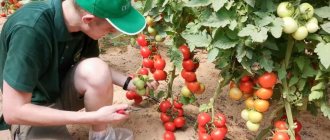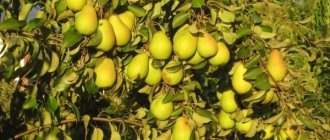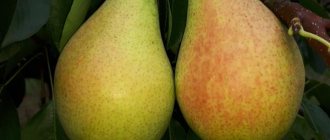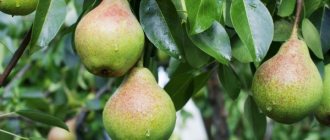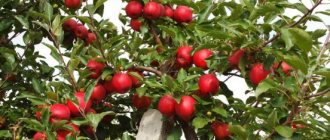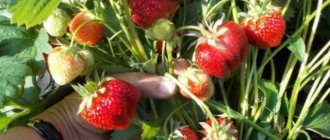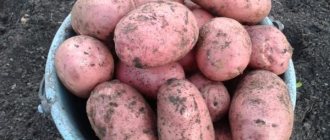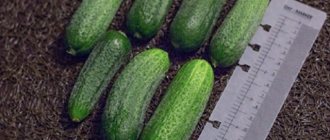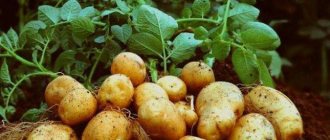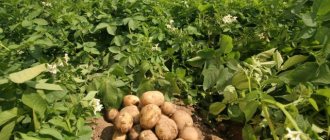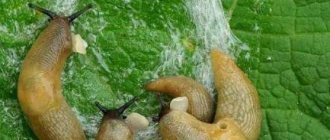Description and distinctive features of the Rogneda pear
Pear Rogneda is a fast-growing variety of domestic selection
Rogneda is the result of crossing Forest Beauty and Tyoma pears. In 1997, testing of the variety began, and in 2001 the crop was included in the State Register and recommended for cultivation in the middle zone. Rogneda is most widespread in the Kaluga and Moscow regions.
The characteristic features for this variety are as follows:
- The pear is medium-sized with a small oval or pyramidal crown. Grows up to 4 m.
- The buds awaken well, but the growth branches develop slowly. Fruiting is concentrated on the ringlets.
- The shoots are slightly curved and covered with green-brown bark. Lentils are small in size and have an elongated shape. The buds are short and take the shape of a cone.
- The leaves have a dark green color, the edges are framed by cloves. The shape of the plates is obovate, the size is medium. Stipules are small.
- The fruits are round in shape, weighing 100–140 g. The skin is thin and has a smooth glossy surface. Ripe pears acquire a light yellow color. Some fruits develop a red blush as a result of exposure to sunlight. The surface of the pears is covered with subcutaneous points.
- The stalks are short and thick. The funnel is shallow, the cup is slightly open.
- The pulp is quite juicy with moderate density, has a slightly oily structure, and is colored beige-white. The taste of pears is sweet, the acid is almost not felt, the taste rating reaches 4.2 points out of 5.
A special feature of Rogneda is its nutmeg aroma, which is reminiscent of the smell of southern pears. The first fruits ripen in 3–4 years. The winter hardiness of the variety allows you to get a good harvest (50–100 kg) even in Siberia. The tree bears fruit for 15–20 years.
History of selection
At the end of the 90s of the 20th century, scientists from the Timiryazev Agricultural Academy obtained and submitted for state testing a new variety of winter-hardy, early-ripening pear. The selection used the Far Eastern variety Tema and the Belgian pear Forest Beauty. The developed variety was named Rogneda. In 2001, it was included in the State Register of Fruit Plants and recommended for cultivation in the Central region of Russia.
Advantages and disadvantages
The Rogneda pear is winter-hardy and hardy, but has a tendency to drop fruit
The Rogneda variety has a significant number of positive properties. However, there are also disadvantages that you should be aware of before you start cultivating a tree in your garden.
Table: positive and negative characteristics of the variety
| Advantages | Flaws |
| High yield level | Periodic fruiting |
| Precociousness | Tendency to fruit shedding |
| Winter hardiness | Inexpressive coloring of pears, which reduces their presentation |
| High taste indicators | |
| Resistance to scab and fruit rot |
Characteristics of the Rogneda pear variety
When choosing new fruit trees, you need to know not only the description of the plant, but also its main characteristics. They determine the region where the Rogneda pear is planted and the characteristics of its cultivation.
Drought resistance, frost resistance
The Rogneda variety is winter-hardy; it also tolerates short-term drought and temperature changes well. The return of frost in the spring during flowering does not depress the plant, and the ovaries do not fall off. Rogneda, in addition to the Central region, began to be grown in the gardens of the Urals and Siberia.
Attention! In one place, a pear bears fruit for 15 to 20 years.
Pollinators of the Rogneda pear
The Rogneda pear variety is partially self-sterile. Therefore, the harvest can be formed if pollinating pear trees grow nearby and bloom at the same time.
As such helpers for the Rogneda pear, you can use one of four varieties, the name and photo of which are presented below:
- Chizhovskaya;
- Memory of Anzin;
- Milada;
- Prominent.
Productivity
The Rogneda variety is distinguished by its early ripening. After planting the seedling (usually 1-2 years), flowering occurs in the fourth year. In the presence of pollinating trees and compliance with agrotechnical standards, depending on the age of the pear, you can collect from 50 to 100 kg of sweet fruits from one plant.
Application area
Sweet pears of the Rogneda variety are consumed fresh. The fruits are an excellent raw material for whole canning; aromatic preserves, jams, and compotes are prepared from them. Pears are suitable for filling pies.
The fruits are collected unripe, and when favorable conditions are created (a cool, dark place) they are stored for up to three months. Transportability is average. Ripe Rogneda pears are difficult to transport over long distances due to their thin skin and abundance of juice.
Advantages and disadvantages
The Rogneda pear variety is popular among gardeners in many regions due to its advantages:
- frost resistance and drought resistance;
- high yield;
- excellent taste;
- resistance to many crop diseases;
- versatility of fruit use.
The Rogneda pear also has certain disadvantages that should not be kept silent. These include:
- fruit shedding;
- short shelf life and insufficient transportability;
- Despite the excellent taste, the presentation of the Rogneda pear is unattractive due to the light color of the skin;
- From time to time, a mature tree rests.
Key features of planting a tree (with photo)
To plant Rogneda, it is advisable to plant pollinating trees nearby
Rogneda can self-pollinate, but this ability depends on the height of the flower stamens and their tendency to self-pollinate. In some cases, pollen sterility is observed, and therefore it is recommended to additionally pollinate the pear. Suitable varieties for this purpose are Pamyat Anzina, Milada, Vidnaya and Chizhovskaya.
The requirements for choosing a location are as follows:
- Plant the tree in sunny, ventilated areas.
- Rogneda prefers a loose, breathable substrate with an acidity pH of 5.6–6. Therefore, it is recommended to choose sandy or loamy soils for planting, but clay soil can also be used.
- The groundwater level in the area should not rise above 2–2.5 m. It is not advisable to use lowlands for planting. In such places, groundwater is located too close to the surface.
Important! In order for the pear to receive enough sunlight, it must be planted at a distance of 3 m from buildings and 5 m from other trees.
Planting is carried out in the spring at the end of April or the first ten days of May, and also in the fall at the beginning of October . The last option is more preferable for the southern regions. In plants planted in autumn, root formation occurs more intensively. In addition, the moisture accumulated in the soil by this time promotes good survival of the tree and accelerates its development. However, such seedlings are more difficult to protect from pests and strong winds, which can lead to drying out of the plant.
The further success of tree cultivation depends on the choice of seedling
When choosing a seedling, you need to carefully examine the trunk, root system and shoots. The criteria by which suitable planting material is determined are as follows:
- There should be no damage, cracks or growths on the surface of the pear.
- The trunk thickness of a healthy tree is at least 1.5 cm.
- The stamp must be even.
- Two-year-old seedlings have three to four lateral branches 30–40 cm long; one-year-old plants may have no branching.
- A healthy root system consists of three to five roots measuring at least 25 cm.
Important! It is quite difficult to evaluate the roots of a plant in a container, so it is recommended to purchase pears from certified nurseries.
Pear is planted in loam or sandy loam soil
The process of planting a Rogneda pear looks like this:
- First, they dig a hole and fill it with fertile composition in advance. When planting in autumn, this is done in 3-4 weeks, and when planting in spring, in the autumn. The soil is prone to settling and if you place the plant in a freshly dug hole, it will be pulled too deep into the ground. Therefore, preparation is done in advance.
- For a pear you will need a hole 80 cm deep and 100–120 cm in diameter. The top layer of soil is mixed with two buckets of humus and 150 g of potassium sulfate or 800 g of ash. In soil with high acidity, 0.5 kg of slaked lime per 1 m2 is first added, it is distributed evenly over the surface, then buried 20 cm. When planting a pear in sandy soil, three buckets of peat are added to the hole, and when using clay soil, two buckets sand _
- If the plant has dry roots, they need to be cut off, then immerse the root system in water for 6–8 hours.
- Before planting, the seedling is treated with a clay mash. To prepare it, 0.1 g of the drug Heteroauxin is diluted in 10 liters of water. After this, clay and peat are added in equal parts, bringing the composition to a creamy consistency. The root system of the pear is dipped into this mixture.
- A mound is formed from the nutrient substrate in a pit. They retreat 20–30 cm from the middle and drive in a peg.
- A seedling is placed on a mound, the roots are spread out and covered with soil, the root collar is placed 5 cm above the ground.
- A hole with a diameter of 35–40 cm and a depth of 10 cm is dug around the trunk, and 2–3 buckets of water are poured into it.
- The soil is mulched with humus or peat. The seedling is fixed to the peg using twine.
Video: master class on planting a tree
Rogneda (pear): description
The trees are of medium height and have a round-oval or wide-pyramidal compact crown.
The shoots of the Rogneda pear are slightly curved, greenish-brown in color, with a dark purple “tan.” Leaves are medium sized.
The Rogneda pear (photo above) has medium-sized fruits (weight about 120 grams), round and sometimes flat-round in shape. The surface of the fruit is shiny, smooth, with medium-thick skin and medium-density pulp. The fruits are light yellow in color, and some of them may have a faint reddish blush. It is strewn with tiny subcutaneous dots.
The pear pulp is beige-white, very juicy, slightly oily, with a pleasant sweet taste and a peculiar nutmeg aroma.
The chemical composition of the fruit is as follows: acids - 0.15%, dry substances - 13.7%, total sugars -7.5%.
Plant care
The yield of a pear depends on many factors, in particular, watering, fertilizing, crown molding, etc. Therefore, gardeners should pay attention to basic agricultural practices in order to harvest a plentiful and tasty harvest from the tree.
Rules for watering and loosening the soil
Watering a pear is an essential step in tree care
When there is a lack of moisture, the roots of the tree cannot fully absorb nutrients, which negatively affects fruiting and slows down the development of the plant . Therefore, watering is one of the mandatory stages of care.
Water is supplied into special grooves 15 cm deep, which are dug along the projection of the crown. After the procedure is completed, the holes are covered with earth. The tree trunk area is loosened, weeds are removed, and then mulched.
Table: pear watering schedule
| Period | Water norm per tree |
| young tree | |
| in spring | 20–40 l |
| In the third ten days of June | 50 l |
| At the end of July | |
| In October | 150–200 l |
| fruit tree | |
| Before flowering | 50–60 l |
| 20 days after the first watering | |
| At the stage of fruit ripening | |
| In autumn during leaf fall | 150–200 l |
Fertilizer application
Fertilizing is necessary for a tree to form a large harvest.
The formation of the crop is influenced not only by watering, but also by fertilizers. Timely feeding will allow the tree to produce a high-quality harvest and also protect against diseases. But you should adhere to a certain scheme so as not to harm the culture.
Table: fertilizing the pear
| Feeding time | Nutrient elements | Norm of nutritional composition per plant | |
| In the last ten days of April | urea or manure is added to the tree trunk circle | For a young pear | For the fruiting pear |
| 100 g of urea or 3 buckets of humus | 10 buckets of organic matter or 500 g of urea | ||
| At the initial stage of flowering | 50 g superphosphate, 40 g potassium sulfate, 1 liter of liquid manure per 10 liters of water | 10–15 l | 40–50 l |
| 40 g of potassium sulfate, 50 g of superphosphate, 50 ml of Ideal per 10 l | |||
| After the flowers fall | 500 g nitrophoska, 1 g sodium humate per 10 l | 30 l | |
| After harvesting pears | Potassium sulfate and superphosphate are scattered around the tree | 300 g of each substance | |
Crown molding
Step-by-step instructions for pruning a pear crown
Every spring, before the buds awaken, pear trees are pruned. In regions with a warm climate, the procedure is performed in the first half of March, but in cold areas it is recommended to postpone it until the beginning of April . Pruning is carried out for the purpose of thinning and forming the crown, which has a positive effect on fruiting.
Some gardeners carry out this procedure in the summer. But the need for such pruning is controversial. Along with the branches in the summer, the leaves, which are responsible for feeding the pear, are also removed.
In autumn, in September, damaged and dry branches are cut off. The work is carried out using pruning shears and a saw. The cutting scheme is as follows:
- An annual seedling is shortened at a height of 50–60 cm from the ground. This will promote the development of branches from the lower buds.
- In a plant 2–3 years old, the central conductor is cut to a quarter of its length. The four most developed shoots are also left, extending from the trunk at an angle of 45°.
- Excess branches are cut into a ring. Shoots with ovaries are given a horizontal position. The remaining branches are bent and fixed in this state with twine.
Further pruning is carried out according to the following scheme:
- Remove branches located at an acute angle, as they break quite often. They also eliminate shoots growing up and inside the crown.
- The conductor is shortened by ¼ part, and young growths are cut by a third. In this case, it is necessary to ensure that the fruit buds from which flowers and fruits are formed are not removed. During the pruning process, do not leave stumps.
- When removing branches thicker than 3 cm, they are cut first from below and then from above. This will prevent damage to the bark.
Important! All cuts must be covered with garden varnish.
It is prepared from 400 g of melted lard or vegetable oil and a similar amount of rosin. The components are melted over low heat until smooth, then cooled and transferred to a jar, which is tightly closed with a lid.
Measures to prepare for winter
Simple care measures will allow the pear to easily endure the winter period
Preparing pears for winter begins after the leaves fall. To do this you should do the following:
- The tree trunk circle is cleared of plant residues, autumn watering is carried out, then the soil is dug up and covered with a layer of sawdust 20 cm thick.
- If there are damaged areas on the surface of the tree, they need to be cut down to healthy wood, then these areas should be treated with copper sulfate and garden varnish.
- You also need to remove dead bark, lichens and mosses.
- After this, the trunk and skeletal branches are treated with a special composition, which helps prevent damage to the pear by pests. To do this, you can use a mixture based on clay and mullein (1:1).
- It is recommended to wrap the trunks of young trees with burlap to protect the plants from frost.
Video: how to prepare a fruit tree for winter?
Care
Proper care of young trees will ensure their active growth without any complications. The Rogneda pear variety is unpretentious, but, like other varieties, it needs regular feeding, pruning and protection from adverse environmental conditions.
Trimming
Two-year-old pear seedlings are pruned in the spring before the buds open. From 7–9 branches, select skeletal ones (3–4 pieces). Such branches are evenly spaced and have an angle of at least 45 degrees. They are cut by a quarter at one level, and the conductor is cut 25–27 cm higher. The remaining branches are not pruned. The next year, the skeletal branches of the second tier are shortened.
To properly form the crown of a pear tree, pruning is carried out on the outer bud. When a tree grows, second-order branches are important. They should be thin and slightly behind the skeletal branches in growth .
Pruning a pear allows you to regulate the processes of growth and fruiting not only of the tree as a whole, but also of its individual parts
Watering
Pear trees prefer watering by sprinkling or irrigation with a special sprayer. Watering should be done up to 5 times a month at the rate of 1 bucket of water per young tree. Watering is carried out in the morning and evening hours.
During the fruiting period (July and August) and the formation of buds for the next harvest, watering is especially important.
Pear trees should be watered based on weather conditions. If there is sufficient soil moisture, watering should be stopped by the end of August, and in dry summers it should be continued until mid-autumn to saturate the tree with moisture .
After each watering, the soil in the tree trunk circle must be loosened to provide the roots with a sufficient level of moisture and air.
Top dressing
One of the important measures in pear care is feeding. The amount and type of fertilizers, as well as the method of their application, depend on the time of year and stage of the growing season.
Table: annual pear fertilization scheme
| Name of fertilizer | Quantity per 1 sq. m | Application period | Method of application |
| Urea | 50–100 g per 10 liters of water | Of necessity | Spraying |
| Superphosphate | 50–60 g | Spring and autumn | Additional fertilizing and basic digging |
| Ammonium nitrate | 15–25 g | Autumn | Main digging |
| Potassium sulfate | 20–40 g 10–20 g | Spring and autumn | Main digging Root feeding |
| Phosphorite flour | 30–40 g | Spring and autumn | Main digging |
| Potassium chloride | 15–20 g | Autumn | Main digging |
| Wood ash | 700–800 g | Spring or autumn (once every 2–2.5 years) | |
| Ammophos | 70–80 g | Spring or autumn | |
| Nitroammofoska | 80–90 g | Spring or autumn | Root feeding during planting |
| Humus | 4–5 kg | Spring or autumn | Upon landing |
| Mullein | 5 l | Spring and autumn | Liquid fertilizer |
Video: how and with what to fertilize pear trees
Possible diseases and pests
Rogneda pear is not affected by scab and fruit rot. However, there are a number of diseases that are dangerous for a tree of this variety.
| Diseases | Symptoms | Treatment methods | Prevention |
| Powdery mildew | A coating forms on leaves, flowers, fruits and shoots, which initially has a gray-white color and then becomes reddish. |
| Digging the soil around the tree to a level of 20 cm. |
| Sooty fungus (niello) | A thick black coating forms on the fruits, ringlets and leaves. First, the fungus forms spots, which subsequently grow together. | Spraying with Fitoverm solution (4 ml per 2 liters of water). |
|
| Rust | The disease manifests itself in the form of the formation of red-brown or orange pads (pustules) on pear foliage. Subsequently, the infection spreads to the petioles and fruits. |
| Burning leaves. |
Photo gallery: typical diseases of the variety
Powdery mildew appears as a white coating
Rust appears as orange lesions on the leaves.
Sooty fungus forms a black coating on leaves
Table: pests attacking Rogneda
| Pests | Signs | Ways to fight | Preventive measures |
| Pear mite | Insects suck the juice from the leaf blades, which leads to the formation of swellings. | At the stage of leaf blossoming, spray with a solution of colloidal sulfur (100 g per 10 l). | Removing dead bark and destroying leaves in the fall. |
| Slimy sawfly | The pest scrapes off the pulp on the upper side of the leaves, as a result of which they turn brown and dry out. | After harvesting the fruits and after 2 weeks, treat with Chlorophos or Karbofos (20 g per 10 l). | Deep digging of the soil. |
| leaf roller | The pest rolls the leaves into a tube and fastens them with a web. | Before bud break and after flowering, treat with Karbofos (30 g per 10 l). | Cleaning leaves in autumn. |
Photo gallery: parasites characteristic of the crop
Pear mite feeds on leaf sap
Leafworm raises larvae in foliage
The slimy sawfly eats leaves and shoots
Detailed characteristics
The yield of the pear variety in question reaches 140 c/ha. From one mature tree you can harvest up to 50 kg of harvest per season. Flowering occurs in the middle period. Flowers are resistant to spring temperature changes.
Despite the fact that the variety is self-fertile, it is worth planting 2-3 pollinators near the tree, which will help increase the yield and quality of fruit. The following varieties are suitable for this: Chizhovskaya, Vidnaya and Pamyat Anzina.
The fruit tree can easily tolerate sudden changes in temperature. The variety is resistant to diseases such as scab and fruit rot.
Recommendations for harvesting and storing crops
Rogneda pear is excellent for fresh consumption or canning
Rogneda is a fast-growing variety. The first harvest is harvested after 3–4 years. The average productivity of one pear is 50 kg. But under favorable conditions, the yield can reach 100 kg of crop. Harvest ripeness of the fruits occurs in mid-August, and consumer ripeness in the third ten days of August or early September.
Harvesting is recommended in dry weather in the evening. At room temperature, fruits are stored for 10 to 20 days. And in a cellar or refrigerator at 2–4°C and a humidity of 85–90% they will last for two months.
Pears of this variety are suitable for making jam, compotes, pie filling, and also for fresh consumption.
Important! Rogneda pears quickly fall off, which significantly reduces their shelf life, so it is advisable to pick the fruits in a slightly unripe state.
Rules for planting and care
The basic rules for growing and caring for the Rogneda pear are not much different from the general care rules for most pears. When choosing a planting site, gardeners need to take into account its love of sunlight.
Attention! Although according to its characteristics this variety of pear is self-fertile, it is recommended to plant pollinator trees next to it (for example, Vidnaya, Chizhovskaya). Neighboring pears will improve fruit quality and increase yield
The main thing is that these trees have flowering periods similar to Rogneda
Neighboring pears will improve the quality of the fruit and increase yield. The main thing is that these trees have flowering periods similar to Rogneda.
You can plant seedlings in both spring and autumn. The pit for this is prepared in advance, while simultaneously enriching the soil. For autumn planting, the hole must be prepared a month in advance, for spring planting - in the fall. The dimensions of the pit are 1 m wide and 0.7 m deep.
For the soil mixture, part of the removed top layer of soil is mixed with manure (30 kg), saltpeter (80 g) and potassium sulfate (150 g). Having filled the hole halfway with the prepared mixture, place the seedling in the middle of the hole, straighten the roots and then sprinkle with the rest of the mixture. The root collar is left 6-7 cm above the planting level. The soil is compacted around the trunk. Tie to the installed support. To reduce moisture loss, some of the leaves of the seedling are removed. After abundant watering of the tree, the tree trunk circle can be mulched with peat.
Important! Water the pear every 7-10 days. The plant responds well to sprinkling
Be sure to remember to water the tree before flowering, during fruiting and after it in the fall.
One of the important points of good fruiting of a pear is pruning the crown in order to form it. This operation is carried out in the spring, before the start of sap flow (in April). It is performed during the first 4 years after disembarkation:
- After a year, the plant is cut back to ¼ of its height.
- In the second year, leave the central core and 3-4 strong branches for the first tier. These branches are cut to ⅓ of their height, and the central conductor is cut to such a height that it protrudes 20 cm above them. The cut areas must be treated with garden varnish.
- In the spring of the third year, the central conductor is cut by 20 cm. A pair of strong branches are aligned in height, retreating 50-70 cm from the lower tier.
- In the spring of 4 years, a second central branch is laid. It will be located 40 cm above the last tier. All other competing branches are removed.
During the summer-autumn period, sanitary pruning is carried out if necessary (to thin out the crown, remove diseased or broken branches). At a more mature age, pears are pruned mainly for the purpose of rejuvenation and increasing its yield.
In the first year of life, a pear seedling does not need to be watered with fertilizers because it was planted in enriched soil. In subsequent years, it is necessary to monitor the condition of the soil and, if necessary, apply the required fertilizers.
An important point in caring for the crop is the procedure for whitewashing the tree trunk in spring and autumn. It will protect the tree bark from spring burns, winter frosts and help against diseases and pests.
Important! With proper agricultural technology, the Rogneda pear perfectly resists diseases. But when it is not properly cared for, it can be plagued by diseases and pests.
To cope with the problems, you will need the following medications:
- For rust, treat with a 1% solution of Bordeaux mixture before buds open, after flowering, then after another 2 weeks. In the autumn, after leaf fall, the tree and fallen leaves are sprayed with a 5% solution of urea.
- For pear worms in the spring, apply karbofos in the proportion of 90 g per 10 liters of water before the buds open.
- For gall mites, treat the tree with colloidal sulfur in a ratio of 100 g per 10 liters of water three times: before buds open, after flowering and in mid-summer.
- When the hawthorn takes over and the caterpillars destroy the buds, flowers and leaves, treat with a solution of karbofos according to the instructions before flowering.
Thanks to its excellent winter hardiness, gardeners can grow Rogneda pear not only in the southern regions of Russia, but also in the northern latitudes. The main thing is to follow the correct agricultural techniques and take into account the characteristics of the variety. And there are many options for preparing dishes from its amazing fruits - it’s all a matter of taste.
Description of the Rogneda variety
Based on the three definitions of fruit tree growth vigor, the variety is more likely to be medium-sized, i.e. his height is within 10 meters. The structure of the tree is standard. The crown is round, sometimes pyramidal, but not dense, due to the reduced growth of young shoots. The trunk and skeletal branches are gray-brown, smooth.
Young shoots are greenish-brown, quite thick, slightly curved, slightly pubescent at the ends. Fruiting is ensured by young ringlets. The species is characterized by vegetative and generative buds, which have visual differences in shape and size. The former form the foliage of the tree, the latter produce self-sterile or self-fertile flowers. The Rogneda variety is described in various sources as self-fertile and as requiring additional pollination. The self-fertility of a flower depends on the height of the stamens and their ability to pollinate. Sterility of pollen and underdevelopment of the male organs of the flower are the path to self-infertility. As varieties that affect the fruitfulness of Rogneda flowers, we recommend the pears “In Memory of Anzin” and “Chizhovskaya” - generally recognized champions of winter hardiness, having a common origin from the breeding laboratories of the Moscow Agricultural Academy. K. A
Timiryazev. For a number of varieties, “Rogneda” is self-fertile and itself is an obligatory pollinator.
Important: For the fertilization of the ovary to be effective, pollinators must have the same timing of the flowering phase as the pollinated hybrid. For complete guarantee, gardeners recommend having up to 3 types of pears on the plot, differing in terms of ripening.
- Pear leaves are rich green, glossy, medium size, egg-shaped; bent along the midrib; the edge is jagged; fastened with a petiole of medium thickness.
- The fruits are small, round (up to 120 g), have a shiny, smooth skin, quite dense, but easily bitten. The color of the fruit is complex: greenish-yellow with a blurred blush that appears at maturity.
Numerous dark green dots shine through the cover of the fruit. Stone cells are barely noticeable when chewed.The pulp is juicy, slightly oily, light beige in color, contains a large amount of fiber, sugars (7.5%) and a tiny amount of acids (0.1%), which makes the taste of the fruit exceptionally sweet.
Pears of this variety have light notes of nutmeg, which gives them the specific aroma of their southern relatives. The dessert merits of the fruit are estimated at 4.1 points on the tasting scale.
- The tree enters the reproductive phase in the 3rd year of life.
- Fruits up to 20 years without clear regularity.
- Productivity varies from year to year, sometimes reaching a maximum of 100 kg per tree. Therefore, in particularly fruitful years, it is recommended to even remove up to 50% of the ovaries after natural fall.
The following pear varieties are also distinguished by high productivity: Tonkovetka, Sverdlovchanka, Samara Beauty, Bere Bosk and Tatyana.
Fruit ripening occurs by the beginning of August or its 3rd decade (the exact timing depends on the region of cultivation, where the variety is classified as late summer, early autumn or autumn). The variety has a hereditary tendency to shed, so it is necessary to harvest the crop before full consumer maturity. Ripe fruits are stored for 1 week under normal conditions and 2 months in a refrigerator.
Pears of this variety suffer less from fungal diseases, showing resistance to scab and gray rot. Severe winters during the variety testing period confirmed the exceptional winter hardiness of Rogneda.
Important: The pear is unpretentious, even heavy clay soils or sandstones can suit it; the main thing is to feed the plant with organic matter in a timely and sufficient manner.
Description of the Rogneda variety
Story
Like the vast majority of other varieties, Rogneda is the fruit of the work of breeders. However, if there are often one or two names of scientists next to this or that brainchild, then a lot of people have worked on this variety. These are S. T. Chizhov, and S. P Potapov, as well as N. V. Agafonov, A. G. Matushkin, V. I. Susov and A. V. Isachkin. Rogneda was specially developed as a frost-resistant variety for the conditions of the Volga-Vyatka, Northwestern and Central regions.
Rogneda has absorbed all the best from its parents and is rightfully considered one of the best varieties for the Middle Zone
Since 1997, the variety has undergone various tests, and already in 2001 it was included in the State Register, being considered promising for cultivation on an industrial and private scale. To get it, it was necessary to carry out several stages of crossing through pollination. The first step was the creation of the Tema variety at the beginning of the 20th century. From him Rogneda inherited the shape of the fruit, good keeping quality, the ability to grow in the conditions of Siberia and the Far East, as well as excellent presentation. The Forest Beauty variety was paired with Tyoma, which gave the new hybrid consistently high yields for 20 years, undemanding soil requirements, drought resistance and durability.
Appearance
The tree is considered medium-sized in height and can reach an average of 4 meters. Its structure is standard. The crown is round, but sometimes can take the shape of a pyramid. It is quite sparse due to the fact that the tree does not grow young shoots very actively. The color of the trunk and skeletal branches is gray-brown, the surface of the bark is smooth to the touch.
The Rogneda tree is quite tall, and the bulk of the harvest is concentrated on young ringlets
Young shoots are green-brown in color, thickened, slightly curved and slightly pubescent at the ends. The bulk of the crop grows on young ringlets.
The lush green leaves are ovoid in shape, medium in size and curved towards the central vein. The edge of the leaf blade is serrated. Petioles of medium thickness.
Rogneda fruits have a round shape, not quite characteristic of a pear.
The fruits are small in size, reaching a maximum weight of 120 g. Their skin is shiny, smooth and quite dense, but can be easily bitten by teeth. They are green-yellow in color most of the time; by the period of full technical ripeness they acquire a weak and blurry blush. Numerous dark green dots appear under the skin. The pulp is juicy, slightly oily, light beige. Easy to chew, stony cells are barely visible. Rogneda fruits contain a lot of fiber, and the minimal acid content makes them truly sweet. This variety is characterized by a light nutmeg flavor and aroma, more typical of southern varieties. According to the tasting scale, Rogneda received 4.1 points.
